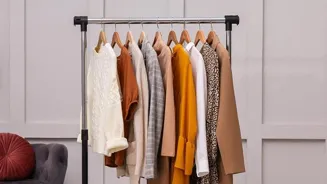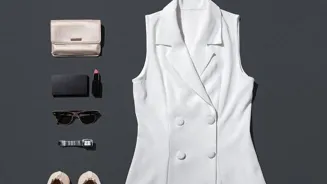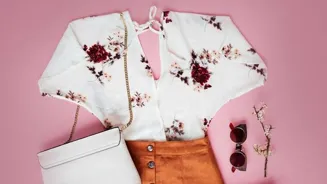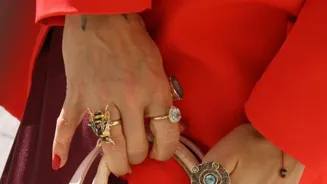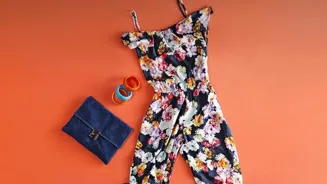Explore the world of Indian fashion: Avoid common faux pas & fix them. Dive deep into style blunders!
Namaste, fashionistas! In the diverse and vibrant world of Indian fashion, where tradition meets modernity,
it's easy to stumble into a sartorial slip-up. But don't fret! We're here to guide you through the common fashion faux pas that many Indians make and, more importantly, how to fix them.
Remember, fashion is about expressing yourself, so let's ensure you're sending the right message. Let's dive into the world of 'fashion mistakes' and make the world our fashion ramp.
Wearing properly fitting clothes is crucial for style and comfort
One of the most frequent fashion blunders is wearing clothes that don't fit properly. We often see folks squeezing into outfits that are too tight or swimming in garments that are too loose. This not only looks unflattering but also makes you feel uncomfortable. So, how do you fix this?
First and foremost, know your size! Get yourself professionally measured, and don't rely solely on the size labels, as they can vary from brand to brand. When shopping, try on clothes before buying them, or if you're shopping online, carefully check the size charts.
If something doesn't fit perfectly, consider getting it tailored. A good tailor can work wonders, transforming an ill-fitting garment into a custom-made masterpiece, especially for traditional Indian wear like salwar suits or kurtis. Secondly, be realistic about your body shape.
Not every style suits every body type, and it is important to come to terms with this.
Comfort is key for confidence: Wear clothes that flatter and fit well
Remember, comfort is key! If you're constantly adjusting your clothes or feeling restricted, it's a sign that they don't fit well this doesn't only work with a fashion statement but will help you gain confidence.
Embrace clothes that flatter your figure and allow you to move freely and stay away from clothes that have wrong sizes. After all, confidence is the best accessory. Getting something tailored or altered is better than just picking out anything out of the rack.
In the end, finding the correct fit for the clothes is very vital.
Indian fashion: vibrant colors and prints, avoid clashes and dark hues
India is known for its vibrant colours and intricate prints, but combining too many of these elements can lead to a visual disaster. While there's nothing wrong with experimenting, it's crucial to strike a balance.
A common mistake is pairing wildly different prints together, like a busy floral print with a bold geometric pattern. This can create a chaotic and overwhelming look. Similarly, combining too many clashing colours can be jarring to the eye.
One of the biggest mistakes is always wearing black or very dark clothes. Dark clothes can absorb sweat and heat therefore causing great discomfort. Colourful clothes are often favoured by Indian culture and can be the go to for an instant refresh.
Mix prints wisely, coordinate colors, limit palette, balance neutrals with brights for style
The fix? When mixing prints, choose patterns that share a common colour or have a similar scale. Alternatively, pair a printed piece with a solid-coloured item. Stick to a limited colour palette, usually consisting of two to three colours.
If you're wearing a brightly coloured outfit, opt for neutral accessories. Or if you're wearing neutral clothes, try and spice things up a bit with colourful and beautiful accessories. Remember, less is often more when it comes to colours and prints.
By following it and wearing it regularly, you will gain a sense of style, by seeing which styles fit suit you best.
Accessories should complement, not overpower, your outfit
Accessories can add personality to your outfit, but piling on too many can be a major fashion fumble. We've all seen someone wearing a statement necklace, oversized earrings, multiple bangles, and a flashy belt all at once.

This creates a cluttered and distracting look that overshadows the outfit itself. Remember what Coco Chanel once famously said: "Before you leave the house, look in the mirror and take one thing off." This is still relevant to this day.
Accessories should complement your outfit, not compete with it.
Choose statement pieces, match metals, be confident
So how do you fix this? Choose one or two statement pieces to focus on, and keep the rest of your accessories simple and understated. If you're wearing a bold necklace, opt for smaller earrings. If you're wearing a statement ring, skip the bangles. Consider the occasion as well.
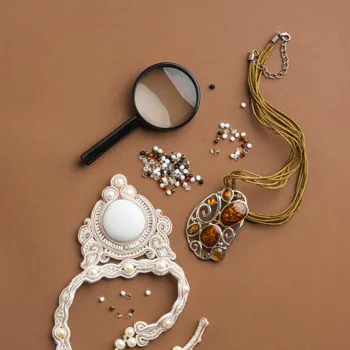
A formal event calls for more refined accessories, while a casual outing allows for more playful options. Be sure to match the metal colours to what you are wearing. By following this rule you can make the most out of the items that you wear.
Remember, confidence is truly all that matters in the end.
Fashion faux pas: Wearing wrong outfits shows lack of respect
Wearing the wrong outfit for the occasion is a classic fashion faux pas, and one we see all too often. Turning up in your casuals to a formal wedding or wearing a heavily embellished outfit to the office is not only inappropriate but also shows a lack of respect for the event or setting.
For example, turning up for a formal event wearing a saree or a suit that is too gaudy may not make a great impression. The same can be said about wearing informal clothes where a uniform is required.
Consider dress code for various occasions to make a good impression
The fix? Consider the dress code before putting on your clothes for the day. If you're unsure, don't be afraid to ask the host or organizer. For formal events, opt for elegant sarees, salwar suits, or evening gowns. For office settings, choose professional attire that is comfortable and appropriate.
And for casual outings, you can experiment with different styles, but always keep it neat and put together. It is also important to take the weather into consideration when putting an outfit together. This will help with making you look and feel at ease, while still making a good impression.
Neglecting details in appearance can harm professionalism
Even the most stylish outfit can be ruined by a sloppy appearance. Wrinkled clothes, chipped nail polish, uncombed hair, and dirty shoes can detract from your overall look. Details matter, and neglecting them can make you look unpolished and uncared for.
The same can be said of wearing old and haggard clothes. People can make a lot of presumptions about you based on your appearance. People in the workplace can see this as unprofessionalism.
Maintain personal grooming for a positive impression
The fix? Always make sure your clothes are clean, ironed and free of stains. Pay attention to personal hygiene. Keep your hair neatly styled, your nails trimmed and clean, and your shoes polished. Regularly groom yourself and make sure your breath is fresh.

These small details can make a huge difference in how you're perceived. Remember, looking good is about more than just wearing expensive clothes, it's about taking care of yourself and presenting yourself in the best possible way.
Fashion is about self-expression, not blindly following trends
While it's fun to stay updated with the latest fashion trends, blindly following them without considering whether they suit your body type, personality, or lifestyle is a surefire way to commit a fashion faux pas. Just because something is 'in' doesn't mean it will necessarily look good on you.
In the end, fashion is about defining yourself, and not just blindly follow something that looks cool.
Be discerning with trends to develop personal style
The fix? Be discerning when it comes to trends. Experiment with trends that resonate with you and flatter your figure, but don't feel pressured to adopt every single new style that comes along.
Develop your personal style by focusing on clothes that make you feel confident, comfortable, and authentic. Fashion is a form of self-expression, so use it to showcase your individuality rather than trying to conform to someone else's idea of style.
At the end of the day, confidence is all that matters.
AI Generated Content. Glance/InMobi shall have no liability for the content

